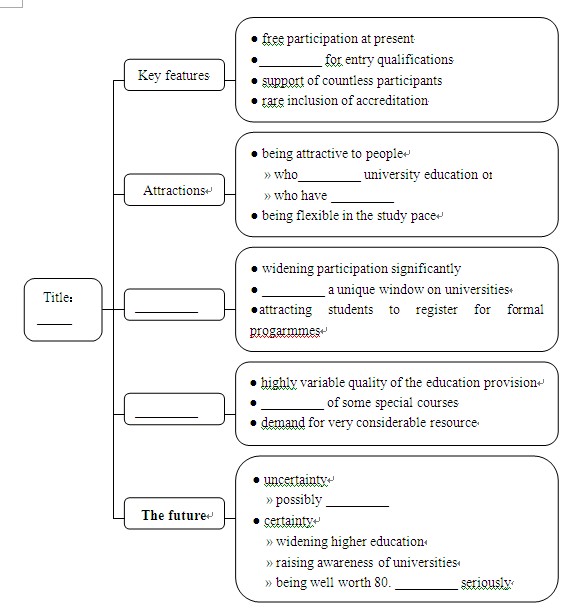While there is no widely accepted definition of MOOCs, their key features are open access:they are currently free to participants, no entry qualifications are required, they support an unlimited number of participants and as yet, very few include any form of accreditation (认证).
Currently offered by some famous universities, MOOCs are attractive to people who do not have the financial resources to meet the growing costs of university education, or who do not have formal qualifications. They also allow participants to study at their own pace.
The potential for MOOCs to deliver education is obviously vast—they could be considered as a huge step forwards in widening participation. They also have the potential to provide a unique window on universities that offer popular and valuable courses, they may attract some participants to register for formal fee-paying programmes at the same or other universities and are likely to promote new ways of on-line education.
However, it is still very early days for MOOCs. The quality of the education provision is highly variable, with many courses offering only recordings of lectures, and delivery is particularly difficult in some special fields that require practical classes, research projects or extensive library access. Besides, wider engagement with participants requires very considerable resource. Even limited feedback or examination becomes a major task if there are several thousand students in the class.
Considering the challenges, some people argue MOOCs will soon evaporate (蒸发). But they certainly provide good opportunity for widening higher education, are a means of raising awareness of universities to audiences of tens or hundreds of thousands, and are well worthy of serious consideration. (271 words)

小题1:MOOCs
小题2:no requirement
小题3:cannot afford
小题4:no formal qualification
小题5:Potentials
小题6:providing
小题7:Challenges
小题8:evaporating
小题9:particularly difficult delivery
小题10:considering
小题1:根据文章第一段MOOCs的特征可知。
小题2:根据文章第一段:No entry qualification are required可知,不需要资格论证。关键词require,而题中要填入的形式是名词形式,故用no requirement。
小题3:根据第二段:MOOCs Are attractive to people who do not have the financial resources to meet the growing costs of university education,or who do not have formal qualifications.这一句中前面部分who do not have the financial resources 可知。没有满足大学教育的成本增长的财政资源的人也可以上大学。
小题4:根据第二段:MOOCs Are attractive to people who do not have the financial resources to meet the growing costs of university education,or who do not have formal qualifications.这一句后半部分,who do not have formal qualifications可直接得出答案。
小题5:根据第三段:The potential for MOOCs to ····和其后它的作用可知。
小题6:根据文章第三段:They also have the potential to provide a unique window on ····可直接得出答案。
小题7:根据最后一段第一句:considering the challenges,可知,上面一段在说这MOOCs所面临的挑战。
小题8:and delivery is particularly difficult in some special fields that....可知。
小题9:根据文章最后一段第一句:considering the challenges, some people argue MOOCs will soon evaporate可知。关键词evaporate。
小题10:根据文章最后一句:and are well worthy of serious consideration.可知,关键词:consideration.
